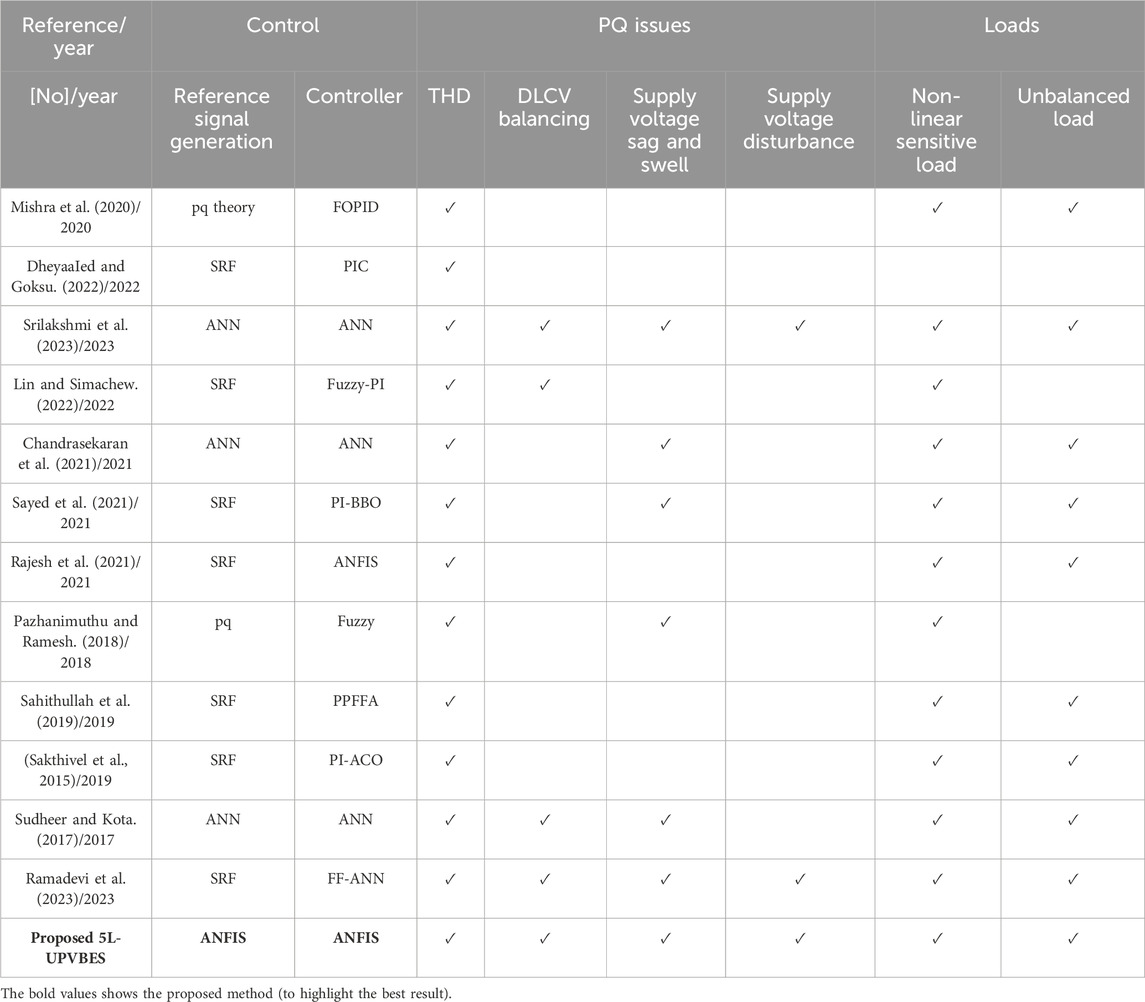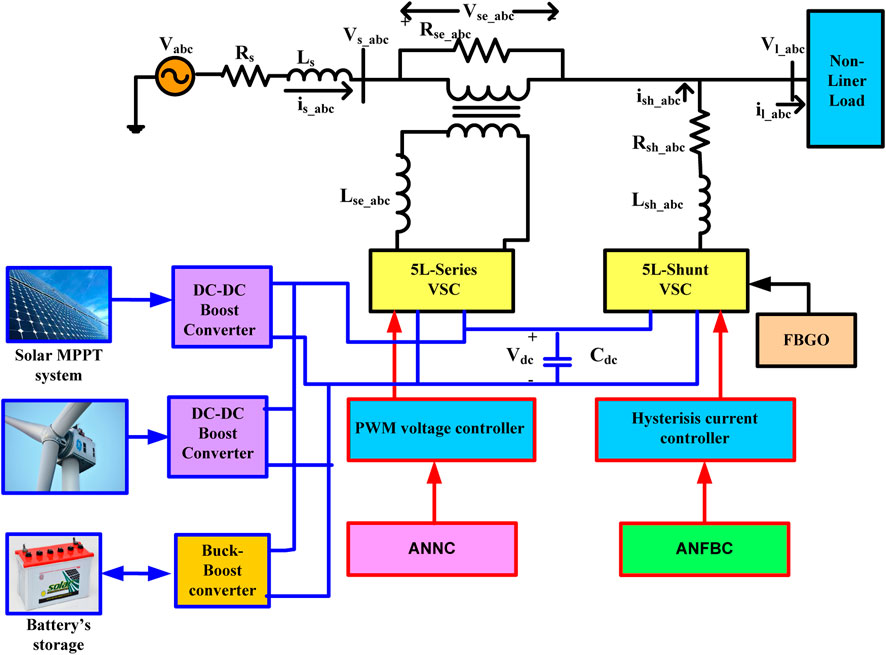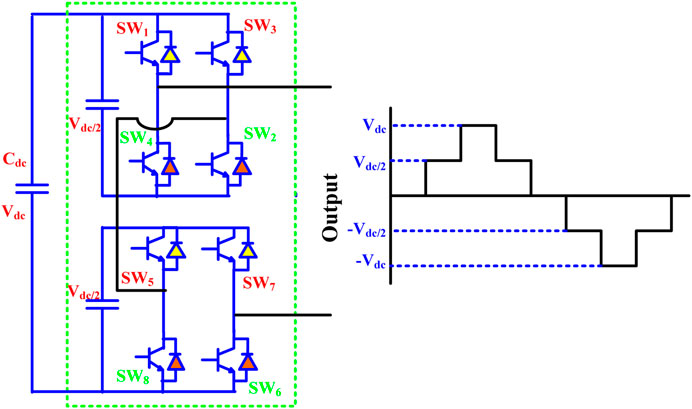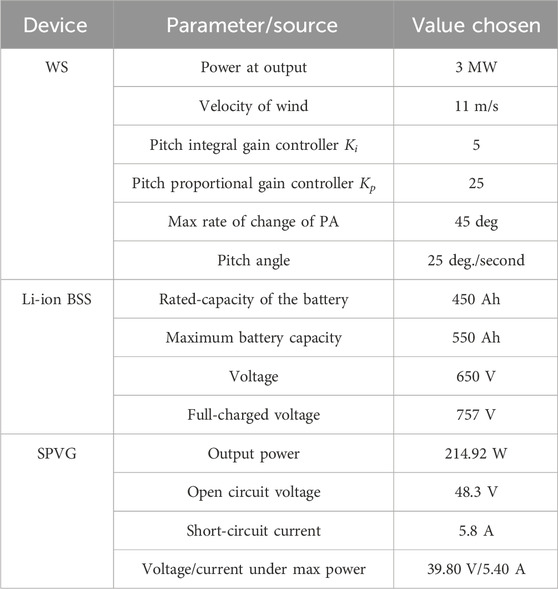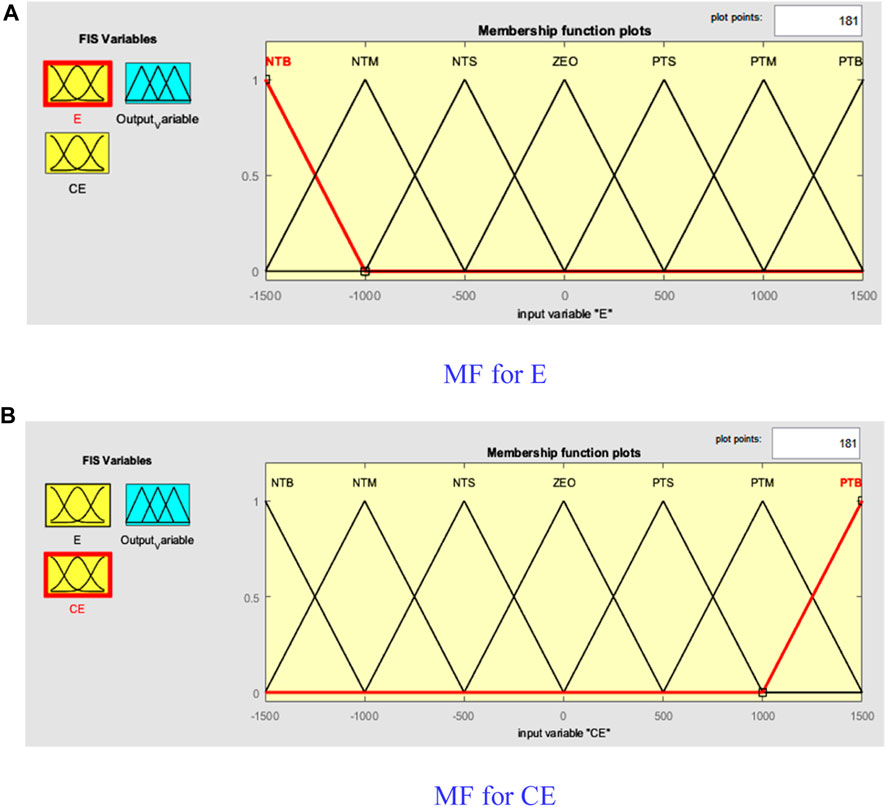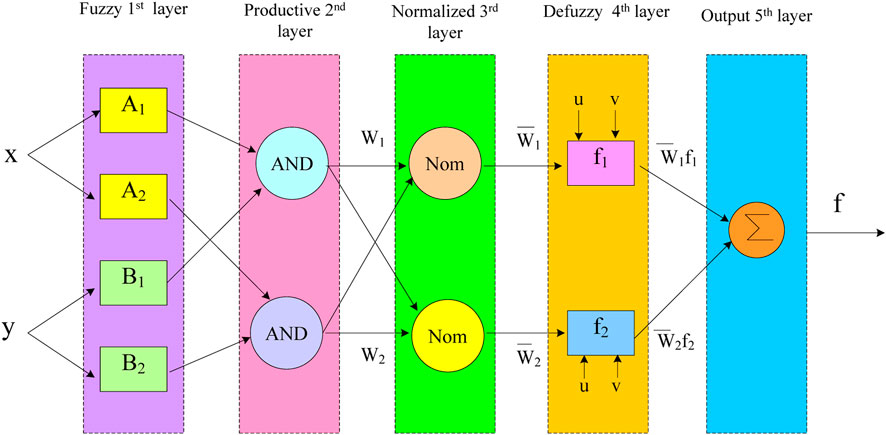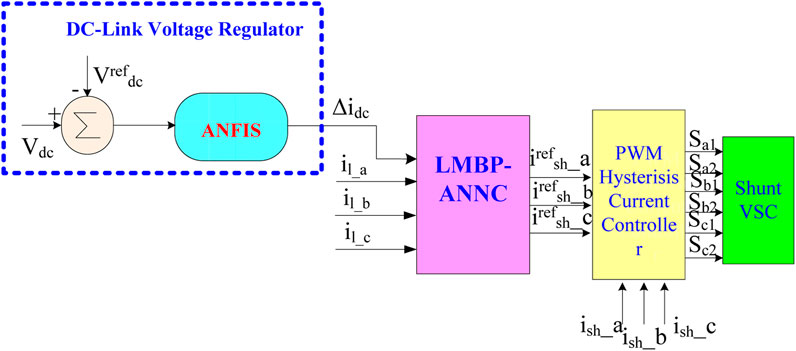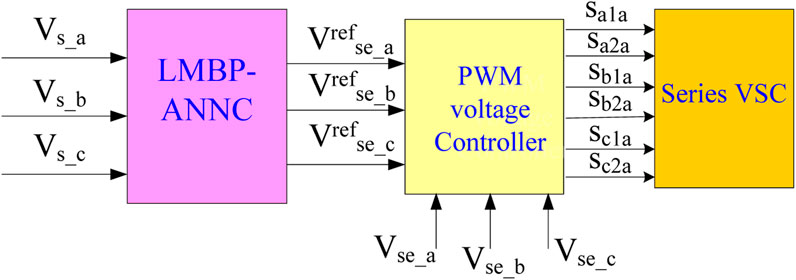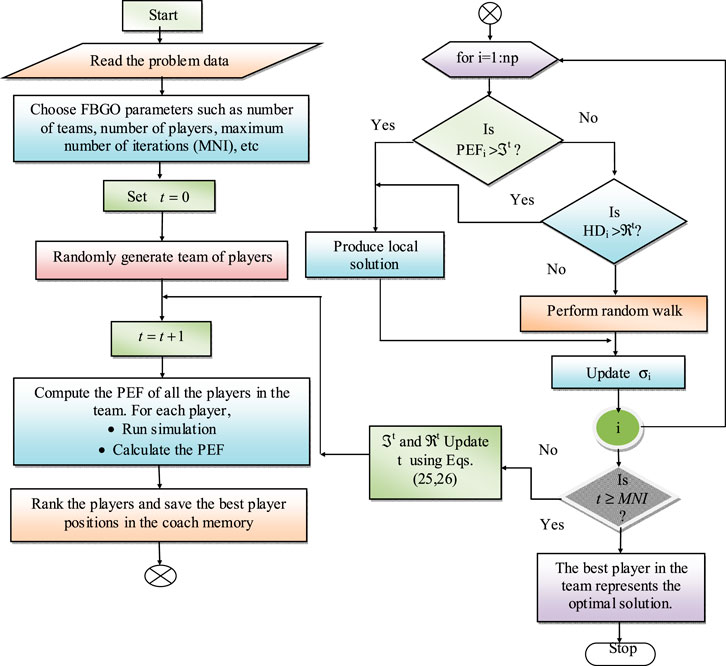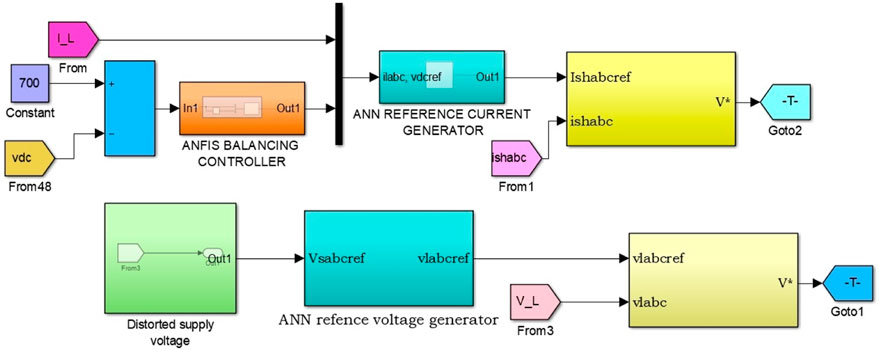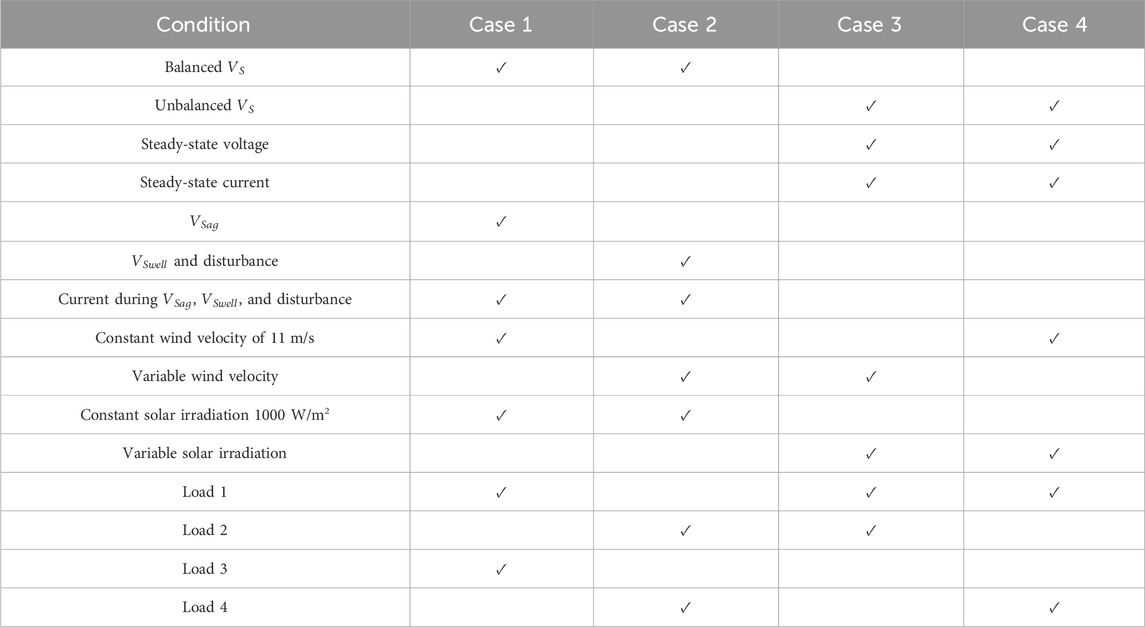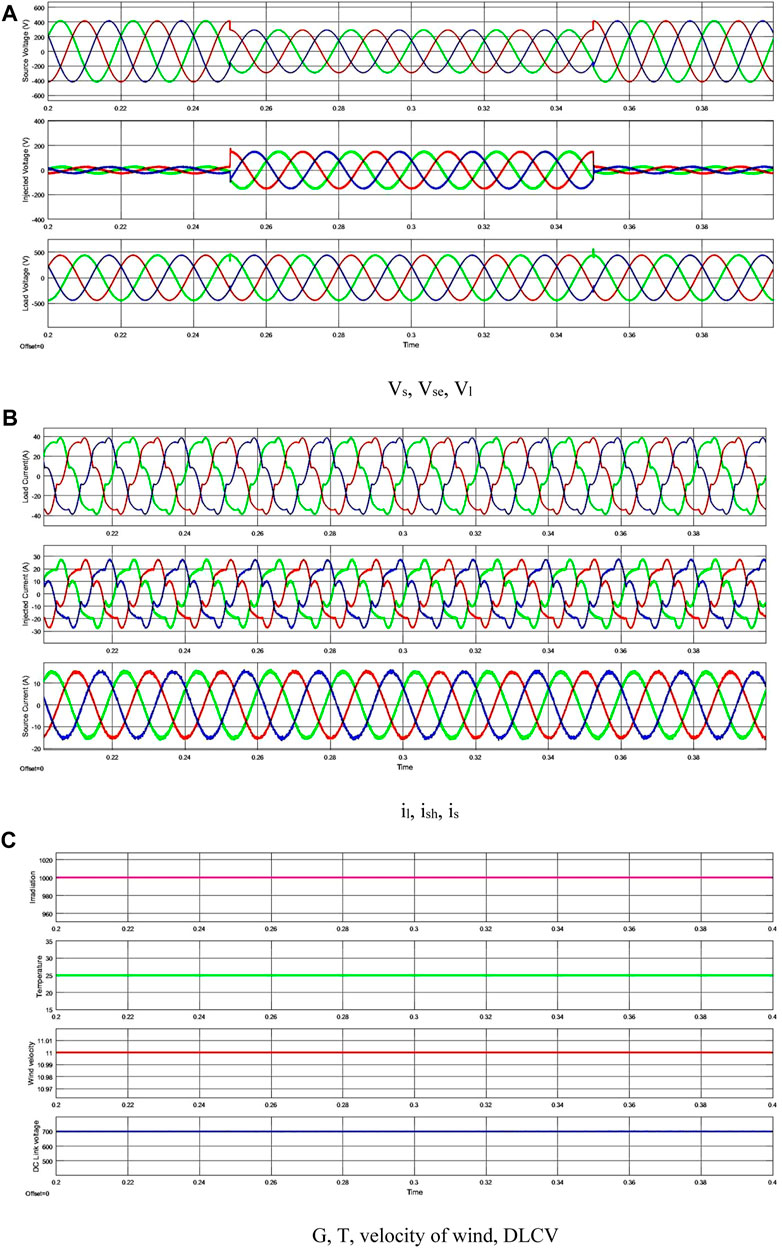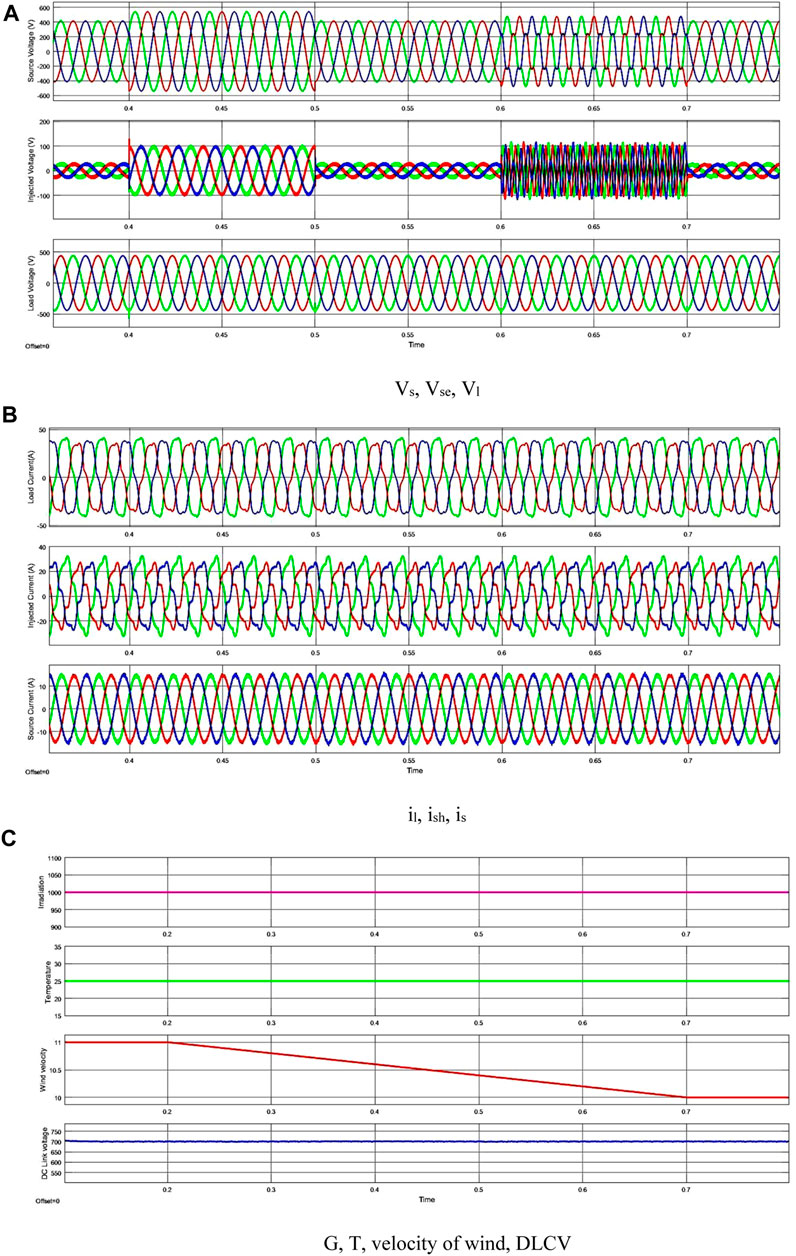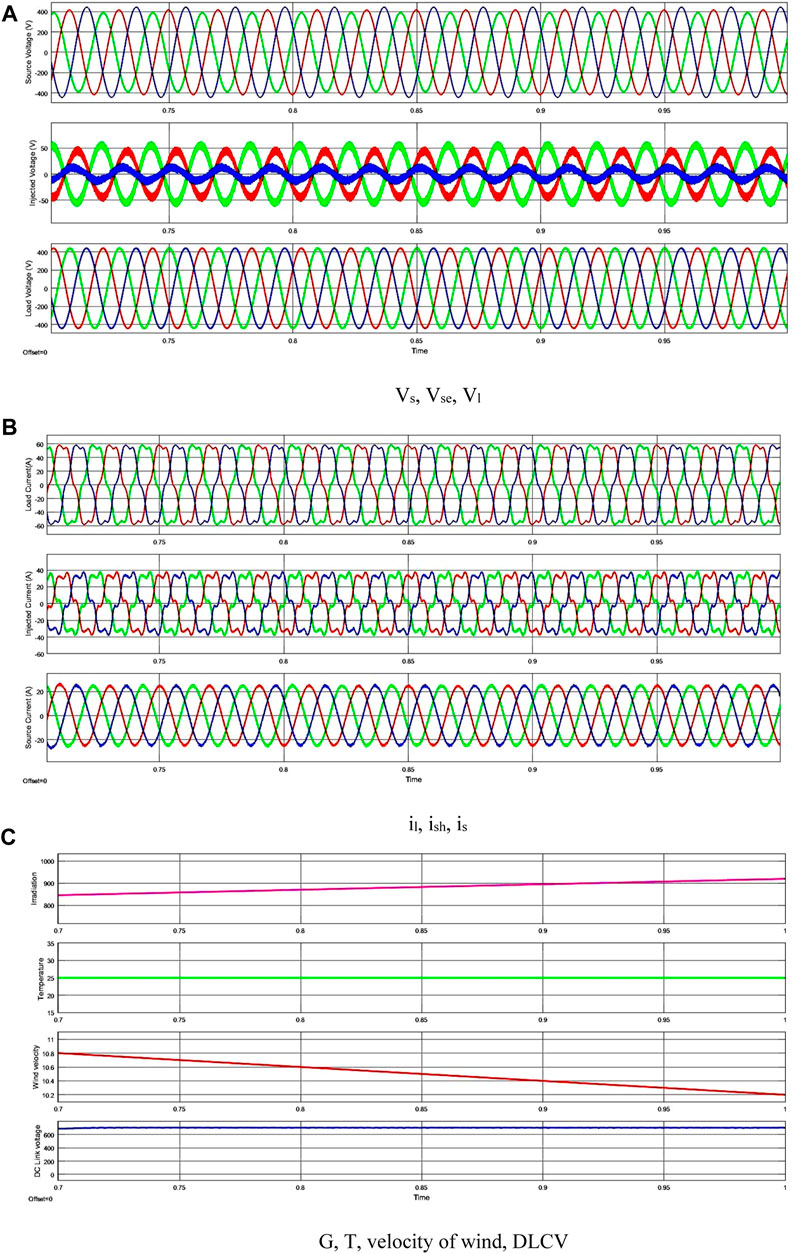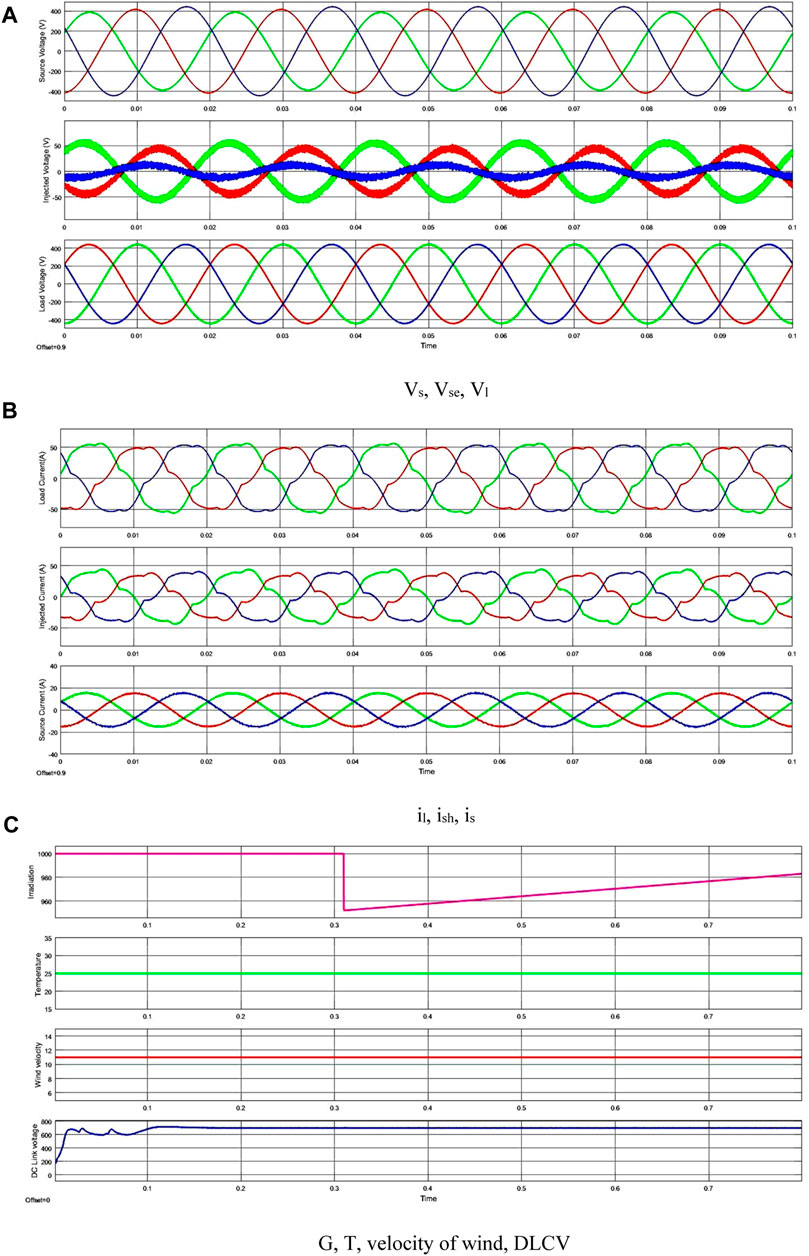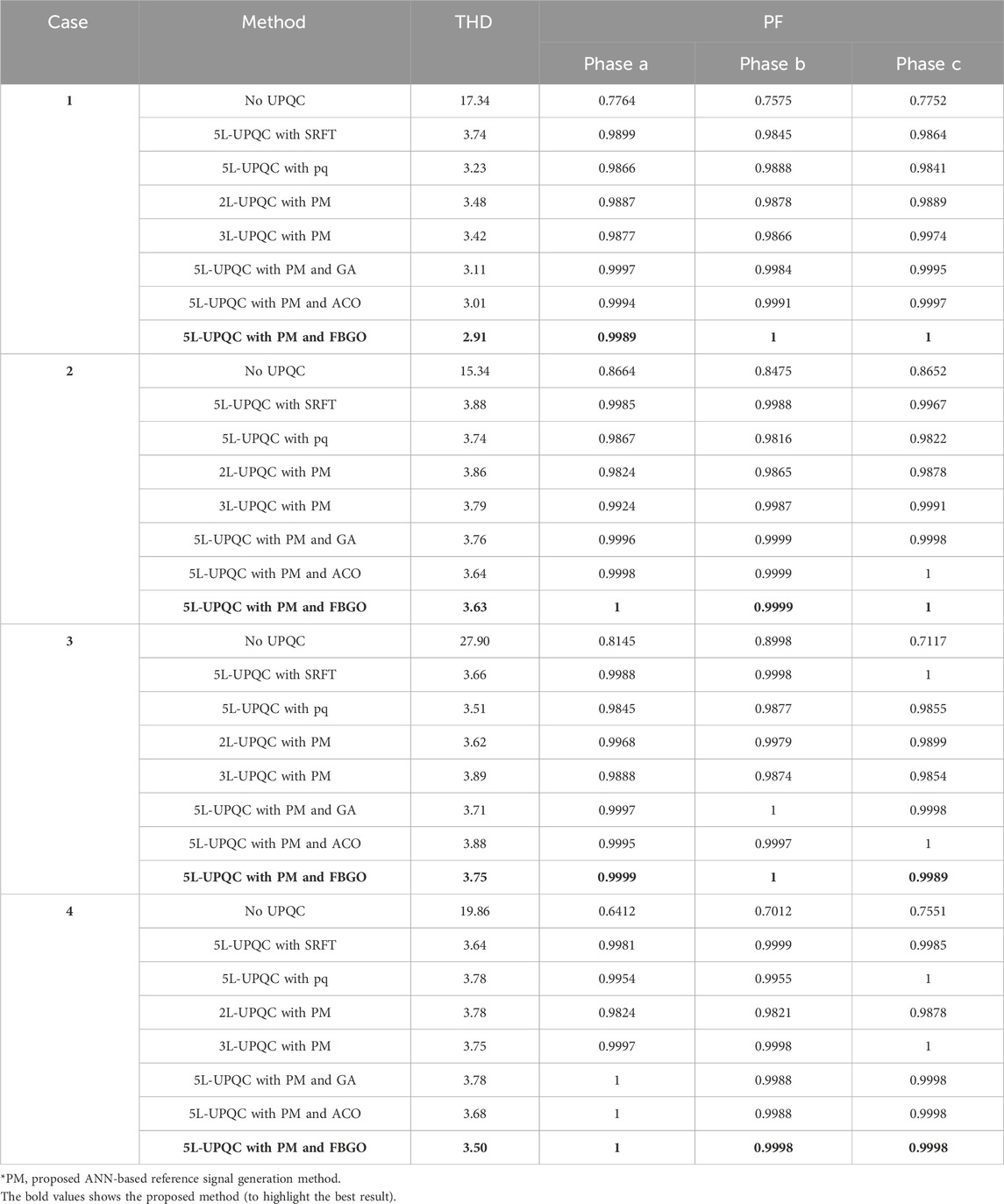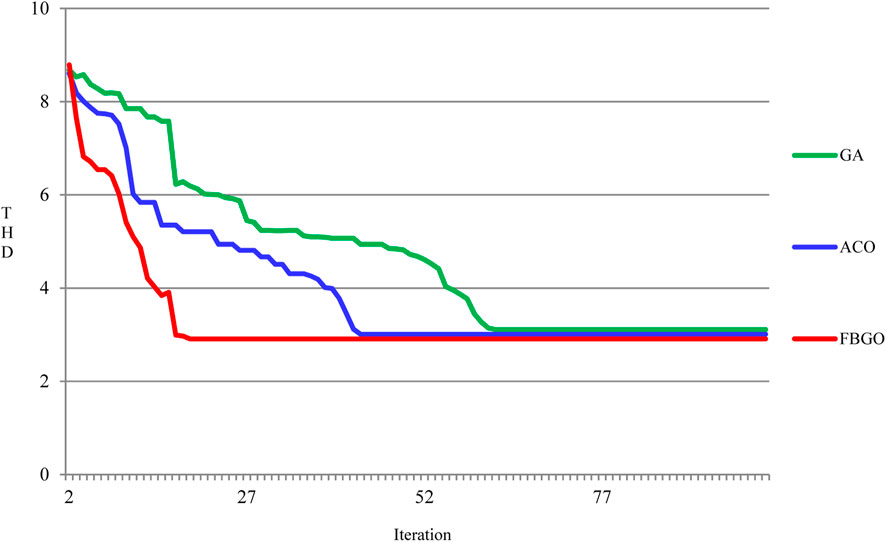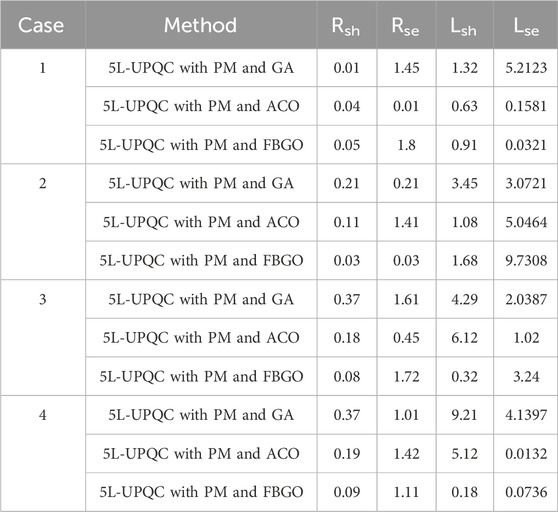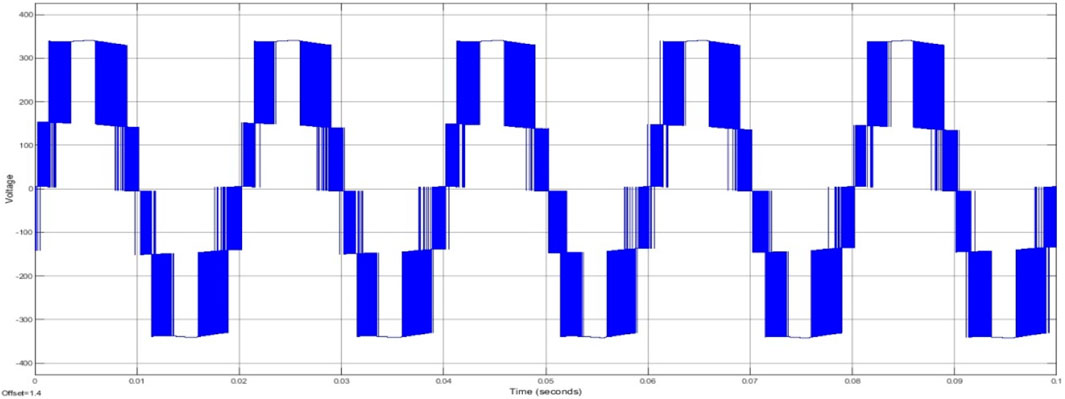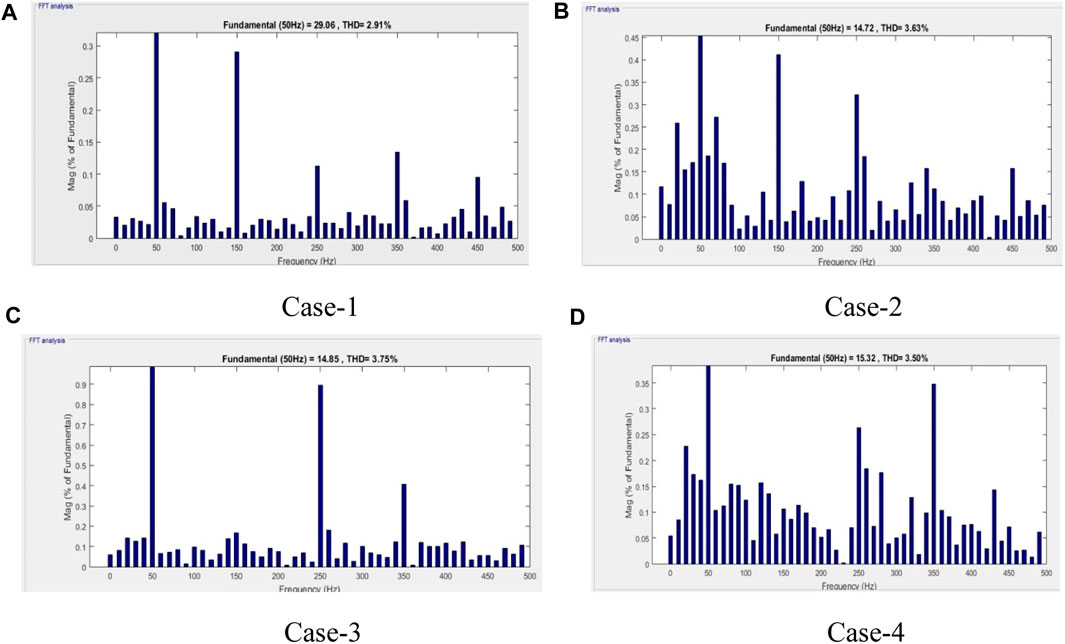- 1Department of Electrical and Electronics Engineering, Sreenidhi Institute of Science and Technology, Hyderabad, India
- 2Department of Electrical and Electronic Engineering, Velagapudi Ramakrishna Siddhartha Engineering College, Vijayawada, India
- 3Department of Electrical and Electronics Engineering, Vardhaman College of Engineering, Hyderabad, India
- 4Faculty of Engineering, University of the Ryukyus, Nishihara, Japan
The power quality (PQ) has been significantly affected by the integration of intermittent non-conventional sources (NCS) into the local distribution system in addition to the adoption of power electronic technologies to regulate non-linear loads. This article combines the H-bridge cascade five-level unified power quality conditioner (5L-UPQC) with the wind power generation system (WPGS), solar photovoltaic power generation system (SPVGS), and battery storage system (BSS) as an effective approach to address PQ problems. The utilization of the Levenberg–Marquardt backpropagation (LMBP)-trained Artificial neural network controller (ANNC) in the UPQC is recommended for generating appropriate reference signals for the converters. This eliminates the requirement for conventional complex conversions, such as abc, dq0, and αβ. Moreover, the artificial neuro-fuzzy interface system (ANFIS) is recommended for achieving a DC-link balance. Football game optimization (FBGO) is utilized to determine the optimal shunt and series filter characteristics. The major objectives of the proposed system are to reduce the current waveform irregularities, resulting in a decrease in the total harmonic distortion (THD), an enhancement in the power factor (PF), the mitigation of supply voltage imbalances and disturbances, and the maintenance of a steady direct-current link capacitor voltage (DLCV), despite the variations in the load, solar irradiation, and wind velocity. The efficiency of the suggested strategy is assessed using four case studies that involve different loads, variable wind velocities, and source voltage balancing conditions. Based on the simulation studies and obtained results, the suggested method significantly decreases the THD to values of 2.91%, 3.63%, 3.75%, and 3.50%. Additionally, it achieves a power factor of unity, which is considerably lower compared to other multilevel schemes that use the traditional symmetrical reference frame (SRF) and instantaneous reactive power (pq) methods. This design has been executed using the MATLAB/Simulink program.
1 Introduction
In recent years, integrating renewable energy systems, like solar and wind, into the distribution network has been encouraged to reduce the stress on converters and ratings. The output of a traditional square-wave inverter is a square wave with a significant amount of harmonics. This necessitates the use of filters to tailor the output and create a sinusoidal shape. When employing traditional square-wave inverters, the cost and size of the filter rise, which becomes a significant disadvantage. An admirable property of multilevel inverters is that they produce leveled output. Compared to traditional square-wave inverters, leveled output requires smaller filters.
1.1 Motivation for the research work
Lately, there has been a growing emphasis on the role of unified power quality conditioner (UPQC) in distributed power generation systems. The integration of UPQC with a non-conventional source (NCS) has become increasingly crucial compared to the traditional grid-connected voltage source converter (VSC). This approach offers several benefits, including the maintenance of a stable direct-current link capacitor voltage (DLCV) amidst load fluctuations, improvement in the power quality (PQ) on the grid, ensuring the safety of sensitive loads against disturbances from the grid side, and enhancing the fault ride-through capability of the converter during transient events. Notably, UPQC combined with NCS systems is particularly well-suited for three-phase three-wire distribution systems. One key aspect of UPQC is the generation of reference signals. In the existing literature, the methods for generating reference signals for the series and shunt compensators of UPQC have primarily relied on complex techniques, such as the dq and instantaneous reactive power (pq) theory. However, in an effort to circumvent these complexities, electrical engineers are increasingly turning to artificial intelligence controllers.
1.2 Literature review
The solar-integrated UPQC was developed to address PQ issues efficiently. In order to obtain the most power and maintain the DLCV balance, a unique fuzzy-based proportional integral controller (PIC) was created for the maximum power tracking technique (Yang et al., 2019). In addition, an innovative hybrid-enhanced method for the shunt active power filter (SHAPF) connected with the artificial neural network (ANN) technology was introduced to minimize current waveform flaws and boost PQ in the distribution network (Ganesan and Srinath, 2019). The best tuning of a fractional-order proportional integral controller for reactive power and harmonic compensation under balanced and unbalanced loading conditions was then used to construct the particle swarm optimization (PSO) and gray-wolf optimization (GWO)-based optimal SHAPF, which was then tested experimentally (Mishra et al., 2020). However, using hysteresis and pulse-width modulation (PWM) approaches, the effectiveness of wind systems associated with UPQC was investigated under various loads and problematic conditions (DheyaaIed and Goksu, 2022). Additionally, using the technique of impedance matching, the flow of power in UPQC was examined on a three-phase system under various working conditions (Zhao et al., 2021).
Additionally, the power flow analysis of UPQC was investigated on a three-phase distribution grid under various operating situations using the method of impedance matching (Yap et al., 2017). Moreover, the fuzzy-based hybrid technique was adopted to achieve the maximum out of the photovoltaics (PVs). However, to reduce complexity, the ANN was considered for UPQC reference signal generation to solve PQ issues (Srilakshmi et al., 2023). To reduce the current total harmonic distortion (THD), the intelligent fuzzy-tuned PIC was created for the hybrid shunt active and passive filters. By utilizing Clarke’s transformation, the performance study was carried out for various loads (Lin and Simachew, 2022). Solar-supplied UPQC was also introduced to lower the THD of the supply current at voltage variations, like sag and swell, by utilizing the ANN. Additionally, under various load conditions, the developed approach was contrasted with symmetrical reference frame (SRF) and pq methods (Okech et al., 2022). An evolutionary PSO and GWO algorithm was proposed to select optimal Kp and Ki values of the PIC of the SHAPF to minimize the THD and manage reactive power, respectively (Mishra et al., 2022). However, to regulate DLCV and to handle power, the feed-forward ANN has been suggested for PV/wind-associated UPQC (Chandrasekaran et al., 2021).
To lower THD in the grid current waveform, the H-bridge inverter-based single phase SHAPF with a modified predictive current control approach was introduced (Belqasem et al., 2022). Furthermore, the microgrid-connected multilevel D-STATCOM was developed to eliminate voltage and current distortions effectively (Sarker et al., 2020). Furthermore, a comprehensive study was carried out on various phase synchronization techniques that were used to control the working of the SHAPF (Yap et al., 2019). The novel technique was introduced for the UPQC to improve the power quality to regulate energy transfer between sources and loads (Szromba, 2020).
For the AC–DC microgrid system, intelligent hybrid controllers, such as fuzzy-PIC and fuzzy PID controllers, were developed to increase the PQ and stabilize the voltage in the presence of D-STATCOM (NafehHeikalEl-Sehiemy and Salem, 2022). However, the GWO was suggested to optimize the gain values of PIC-based UPQC to reduce the THD for both linear and non-linear loads (Marcel et al., 2023). Hysteresis current control was used for pulse generation, stabilizing the DLCV for SHAPF to effectively deal with PQ issues. Additionally, linear and non-linear loads were considered to study the performance (Imam et al., 2020). Biogeography-based optimization (BBO) was selected to obtain optimal gain values of the PIC and for fast action in fault identification with higher accuracy with the motive of stabilizing DLCV fluctuations (Sayed et al., 2021).
The hybrid fuzzy-ANN control technique has been adopted for UPQC to minimize the current THD and voltage fluctuations and improve the network usage (Renduchintala et al., 2021). The improved bat and moth–flame metaheuristic optimization methods were hybridized to solve the PQ issues by the optimal selection of the gain values of PIC (Rajesh et al., 2021). The fuzzy logic controller (FLC) was developed for the series-active power filter (SeAF) of the distribution network to minimize the current- and voltage-related PQ problems (Pazhanimuthu and Ramesh, 2018).
The predator–prey firefly algorithm was selected for the optimal selection of the gain values of the PIC adapted to the SHAPF to reduce the THD and to enhance the power factor (PF) (Sahithullah et al., 2019). Soccer match optimization for the optimal selection of weights for the ANN controller was suggested for PV/battery-associated UPQC to solve PQ issues (Koganti et al., 2022). The ant colony optimization (ACO) algorithm was chosen for selecting the Kp and Ki values of the PIC for the SHAPF to reduce the THD under several loading conditions (Sakthivel et al., 2015). An adaptive novel hysteresis band with the FLC was suggested to the PV-powered nine-level VSC of UPQC to receive fluctuation-free signals (Hassan et al., 2022). Next, the soccer match algorithmic approach was suggested for the appropriate choice of PIC gain values for UPQC to successfully handle both voltage fluctuations and current distortions (Srilakshmi et al., 2022).
For UPQC, the hybrid control strategy combining the FLC and ANN features was suggested as a way to lessen the flaws in the grid’s voltage and current waveforms while still maintaining DLCV for dynamic loads (KogantiKrishna and Reddy Salkuti, 2022). The ANN-based method was suggested for five-level UPQC to control the PQ problems (Sudheer and Kota, 2017). The firefly-based optimization algorithm was used to train the ANNC, which was developed for the shunt VSC for the PV/battery UPQC to reduce the mean-square error (MSE) and minimize the THD (Ramadevi et al., 2023). The self-tuning filter-based method was developed for UPQC integrated with renewable sources to address PQ issues (Mansoor et al., 2023). The Levenberg–Marquardt backpropagation (LMBP)-trained ANN controller was adopted for UPQC to mitigate the current- and voltage-related PQ problems efficiently (Zhou et al., 2006).
Moreover, a special improved UPQC with several objectives and variables that can be optimized using the BHO and PSO techniques to alter the PIC variables has been designed to decrease the system THD (Khosravi et al., 2023). Furthermore, a suggestion was made to use power-compensating approaches to connect the AC/DC microgrid to the grid in order to lower the harmonic amplitudes. This entails maximizing the gain coefficients in specific filter compensation apparatuses. The PIC’s optimized coefficients were linked to the cost functions that took into account the inaccuracy of the controller, voltage harmonics, and current harmonics (Khosravi et al., 2021).
1.3 Key contribution
The literature listed in Table 1 makes it abundantly evident that the majority of the works mostly concentrated on different controllers using the pre-existing traditional control methods for UPQC that included complicated Park’s and Clarke’s transformations. In addition to an artificial neuro-fuzzy interface system (ANFIS) controller for DC-link balancing, this publication develops ANN-based reference signal generation for the PV/battery-coupled DC-link UPQC.
The novelty of this manuscript is highlighted in the steps below:
➢ Introducing the Levenberg–Marquardt-trained ANNC for generating effective reference signals in order to eliminate the necessity of complex abc–dq0–αβ0 conversions, i.e., SRF and pq theories in UPQC.
➢ The optimal selection of the H-bridge cascade 5L-UPQC shunt and series filter parameters for effectively reducing the imperfections in the current waveforms effectively using football game optimization (FBGO).
➢ Proposing the hybrid ANFIS controller to maintain a constant DLCV.
➢ Incorporating solar power with storage systems of the DC link of 5L-UPQC to reduce the stress and burden on the VSC, which supports and meets the load demand and maintains a constant DLCV during load variations.
➢ The objective of the proposed system is to diminish the source current THD and eliminate the grid voltage side troubles, like disturbance, swell, and sag.
➢ Additionally, the suggested ANFIS for 5L-UPQC in association with the PV, wind, and battery storage system (BSS) (5L-MUPQC) is examined on four test cases for several types of loads, solar irradiation, and wind velocity to show its superior performance.
This paper is structured as follows: Section 2 shows the modeling of 5L-UPQC, Section 3 explains the proposed control scheme, Section 4 demonstrates the results and discussion, and Section 5 concludes the manuscript.
2 Modelling of the developed 5L-MUPQC
Figure 1 shows the proposed 5L-UPQC configuration, which connects the PVs and batteries to the DC link of UPQC. Combining series and shunt VSCs creates UPQC. By supplying the appropriate compensation voltage via the injecting transformer and the inductor, the SHAPF seeks to resolve grid-side voltage-related issues. The SHAPF is similarly connected to the grid via the interface inductance. By injecting a sufficient compensating current, the SHAPF seeks to decrease the current waveform harmonics and maintain the DLCV constant with a minimal settling time.
One of the best structures is the multilevel inverter cascaded H-bridge topology, which requires no clamping tools or components. Although the cascaded H-bridge topology’s layout is straightforward, more DC sources are needed to power each single H-bridge cell. Two H-bridge cells are cascaded into a five-level H-bridge structure, and every single H-bridge cell is powered by a DC source. Figure 2 displays a multilevel inverter five-level cascaded H-bridge arrangement; it also displays the cascaded H-bridge’s 5L voltage output in the phase. The five-level output is produced by sequentially triggering power switches as the whole DC-link voltage is divided across two H-bridge cells. Figure 2 shows the power switches used for five-level cascaded H-bridge, and its switching order is given in Table 2.
2.1 Selection of Cdc
The value of
2.2 Selection of
The shunt VSC is linked to the network through an inductor (
assuming m is 1,
Assuming
2.3 External support for 5L-MUPQC at the DC link
The solar/battery-fed DC link is proposed for the diode-clamped 5L-UPQC. It consists of a hybrid solar and battery energy system to regulate the DLCV at changing loads. External support can reduce the converter ratings and stress by lowering the utility’s demands. The equation for the power demand of the suggested technique is given in Eq. 5:
The PV model used in this work was selected from the Simulink library. To create the necessary quantity of voltage and current, the PV modules are connected in series to form a string. Some of these strings are then connected in parallel. Here, Eq. 6 describes the solar output. Figure 3 illustrates the PV cell properties for a fixed temperature and changing irradiance. The incremental conductance-based MPPT is adopted to extract the maximum output from the PV system (Srilakshmi et al., 2023):
Moreover, the BSS aids in supporting the DLCV’s stabilization. The cells are stacked in parallel or series in a battery to provide the necessary voltage and current. Since Li-ion batteries have benefits like slower discharge and inexpensive maintenance costs, this work chooses them from the Simulink library. The state of charge of the battery (SOCOB) (Koganti et al., 2022) is expressed in Eq. 7:
The SPG will choose whether to charge or discharge the battery while adhering to the restrictions stated by Eq. 8. Figure 5 depicts the battery’s drain. Table 3 displays the power division at DC’s link capacitor, and Table 4 provides the ratings selected for PV, battery, and wind systems. Figure 4 shows the control mechanism for the solar, wind, and battery system fed to the DC link.
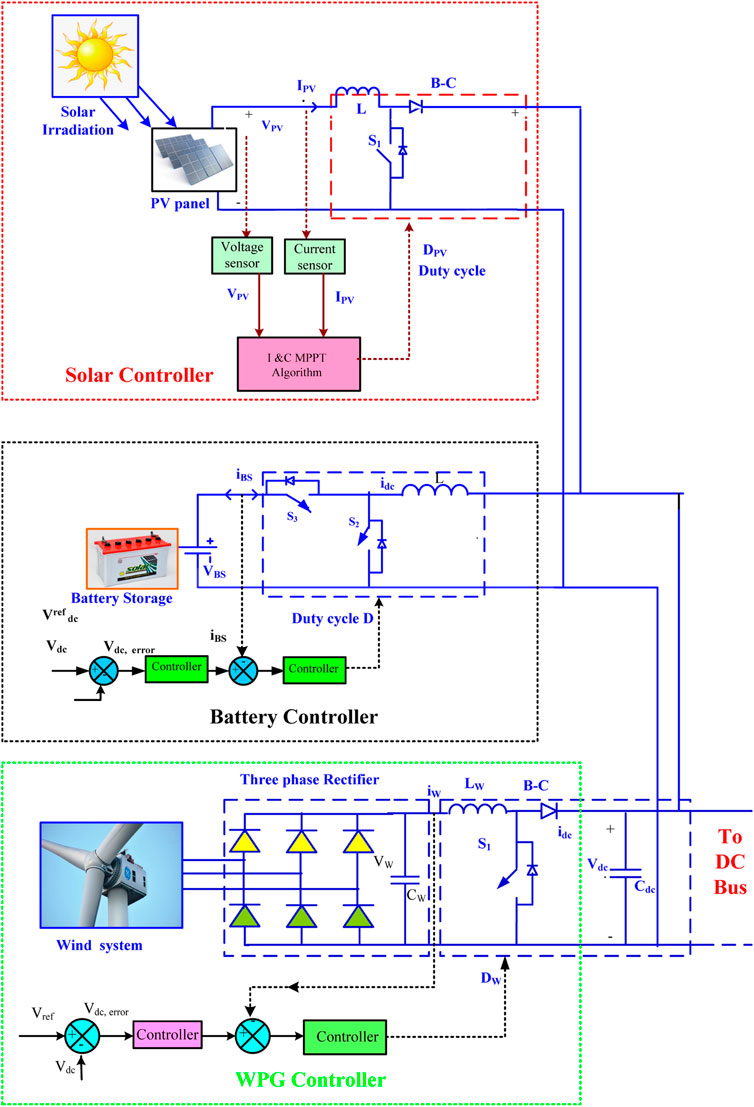
FIGURE 4. Control of photovoltaic (PV), wind, and battery systems with boost and buck–boost converters.
The wind-generated AC voltage is rectified into the DC voltage, which is then boosted through a boost converter. A permanent magnet synchronous machine was considered in the present work. Wind power generation (KogantiKrishna and Reddy Salkuti, 2022) is given by Eqs 9–13:
3 Proposed control scheme
Generally, chances take place at the distribution side during dynamic load variations. For a brief period, the system must be restored to its initial value in order to function normally. Here, using the recommended ANNC, the PWM hysteresis current control for the shunt VSC and gate pulses for the series VSC are produced by the PWM technique.
3.1 Shunt VSC
The major goal of the SHAPF is to manage the DLCV under faults and dynamic loading circumstances and to suppress current signal distortions by injecting the compensating current. The output layer (OL), input layer (IL), and hidden layer (HL) components of the ANN make up its structure, where the IL gathers data supplied as input and sends it to the HL. When linked between the IL and the HL, it is afterward multiplied by the appropriate weights on the connected links. Here, calculations are performed with a chosen bias on the HL, and the outcomes are gathered in the OL.
In this case, the LMBP-based ANN is chosen. To get the desired output, the weights of the link are adjusted during training by analyzing the mistake. For ANN training, where the performance function is the MSE, the LMBP training method is used. The LMBP algorithm updates the weights using the obtained derivatives, which has the advantages of rapid convergence and effective learning.
3.1.1 ANFIS
It is advised that the ANFIS keeps the DLCV constant. The proposed ANFIS combines fuzzy logic and ANN elements to create an intelligent hybrid controller. However, in order to keep the DLCV constant, the obtained DLCV—whose output, E, and CE are taken into consideration—is compared to the selected reference DLCV. As seen in Figure 5, the inputs given to the ANNC are first trained based on the Gaussian membership function (MSF) to yield the best results. The ANFIS is primarily composed of five layers: the first layer, called fuzzification, produces the fuzzy MSF, which is given by Eq. 14 and is depicted in Figure 5.
where
The representation of the triangular MSF is exhibited by Eq. 15:
where bi is the fuzzy set i’s point of greatest support and xmax–xmin (high and low bonds) is the range (world of discourse) of x. The inputs that are taken into consideration are the negative-big (NEB), negative-medium (NEM), zero (ZOE), positive-small (PES), positive-big (PEB), positive-medium (PEM), and negative-small (NES) input. MF’s inputs are displayed in Figure 5. We can see the fuzzy rule base in Table 5.
Furthermore, the AND operator is used in the second layer (where fuzzy rule weighting is carried out) to calculate the firing strength
The third layer is where the values from the previous layer are normalized. Normalization is achieved at each node in this layer by computing the ratio, as given in Eq. 17, of the firing strength (true values) of the kth rule to the sum of the firing strengths of all other rules:
The self-adaptive capability of the ANNC is executed through the application of the inference parameters
As shown in Eq. 19, the inputs are finally combined in the fifth layer to provide the final required total output of the ANFIS. The suggested ANFIS’s configuration and the MSF for inputs 1 and 2 are shown in Figure 6.
In this work, the ANFIS is trained to keep the DLCV stable and to generate reference current signals. However, for keeping the DLCV constant, the reference DLCV (Vrefdc) is compared with the actual DLCV (Vdc); its error is chosen as input data, Δidc. Subsequently, the load currents (il_abc) and the DC loss component (Δidc) are regarded as the input, whereas the reference currents (irefsh_abc) are regarded as target data, as depicted in Figure 7. Figure 8 shows the selected neurons’ structure.
3.2 Series VSC
The main function of the series filter is to reduce source voltage signal imperfections by injecting an appropriate compensating voltage to keep the load voltage constant. The suggested series VSC reference signal production strategy is shown in Figure 9, and the construction of an ANN with an HIL of 200 neurons is shown in Figure 10. The supply voltages (Vs_abc) are regarded as data for the input to produce the reference voltage signals (Vrefse_abc), whereas the reference voltage is regarded as the goal data to the ANN. Moreover, the PWM produces pulses for a series converter.
4 FBGO-based shunt and series filter parameter selection
FBGO is a metaheuristic optimization algorithm that simulates the behaviors of football players. Within this framework, a team of players is established, and the position of each player corresponds to a solution point on the football field. The evaluation of each player’s performance is based on the performance function (PEF), which is derived from the objective function (Eq. 26). The movements of these players, guided by a team coach, mimic the process of obtaining the ball and reaching a goal, involving two distinct phases: random walk and coaching. The proposed method is used to determine the optimal values of resistance and inductances of shunt and series filters (variables) with the goal of minimizing the THD. Each player is defined to denote the problem variables, as given in Eq. 20. The upper and lower bounds of variables are given in Table 5.
The random player movements, under the supervision of a team coach, follow a two-step process to accomplish the tasks of retrieving the ball and reaching the goal, as detailed below.
4.1 Random walk
Individually, every player embarks on a random walk, aiming to locate a position closer to the ball with the aspiration of scoring a goal. During this phase, there are no specific instructions or guidance from the coach.
σi is reduced for every iteration by σi = σiϴ.
4.2 Coaching
The player heightens the pressure on their opponent by advancing as directed by the game coach, taking into account the hyper distance (HD) between players, which is determined by Eq. 23:
Players whose HD values exceed a certain threshold, denoted as “
The value of “
In the substitution plan, the team coach replaces ineffective players with better players to improve the chances of achieving a goal. Each proficient player, whose PEF exceeds the cost constraint value (
where
4.3 Solution process
A set of players is initially generated with random values, and their PEFs are calculated using Eq. 21. Following this, they are ranked based on their PEF. The HD between each player and the most efficient player is computed. Subsequently, the random walk and coaching steps are carried out using Eqs 22, 23, respectively. The entire cycle, encompassing the PEF evaluation, HD computation, and the execution of random walks and coaching, constitutes the iteration. This process is repeated until convergence is achieved. The player with the highest PEF is identified as the optimal player once convergence is reached. Figure 11 gives the flowchart of the algorithm for the solution. FBGO has a higher efficiency with faster convergence; it is capable of solving multi-objective and complex engineering problems effectively. Moreover, it has its own limitations, like being a computational burden.
5 Results and discussions
Using MATLAB 2016a, the suggested M-UPQC with ANFBC was created. Figure 12 displays the suggested method’s Simulink model. Table 6 also shows the system and the UPQC parameters with the loads being taken into account. To demonstrate the improved performance of the designed system, Table 7 presents four different case studies with various combinations of non-linear loads and PQ issue conditions with variable wind velocity, solar irradiation, and so on. In this instance, the voltage source (VS) is chosen as an unequal phase supply for instances 3 and 4 and a balanced phase supply for studies 1 and 2. Cases 1 and 2 take into account the voltage sag, voltage swell, and voltage disturbance difficulties. Therefore, the goals were to minimize the THD, increase the PF, and maintain a constant DLCV. With the purpose of demonstrating the effectiveness of the suggested ANFBC, synchronous reference frame theory (SRFT) comparison analysis was performed. Using Eq. 27, the PF is calculated from the THD.
The voltage sag/swell (
The injected voltage by the series filter is calculated by Eq. 29:
The injected current by the shunt filter is calculated by Eq. 30:
In case 1, the VS is initially considered to be balanced. To assess the performance of the SHAPF, a 30% balanced sag was intentionally introduced into the source voltage between the time interval of 0.25 and 0.35 s, as depicted in Figure 13A. However, the ANNC system effectively detects the voltage dip, applies a suitable compensating voltage through the coupling transformer, and maintains a consistent voltage at the load terminals. To further evaluate the performance of the SHAPF with the proposed ANFIS and FBGO optimally selected filter parameters, both loads 1 and 3 were considered simultaneously.
As shown in Figure 13B, the load current waveform exhibited contamination and non-sinusoidal behavior but remained balanced. The suggested approach mitigates the irregularities in the current waveform, leading to a reduction in the current’s THD from 17.34% to 2.91% while concurrently raising the PF from 0.7764 to nearly unity. Furthermore, the proposed method sustains a steady DLCV for the load under the conditions of 11 m/s wind velocity, 1000 W/m2 irradiation, and a constant temperature of 25°C, as represented in Figure 13C.
In case 2, similar to case 1, the source voltage is initially assumed to be balanced. To examine the working of the SHAPF under the conditions of a 30% swell and disturbance, these events are introduced during the time intervals of 0.4–0.5 s and 0.6–0.7 s, respectively. However, it is evident from Figure 14A that the ANNC effectively recognizes the voltage increase and disturbance, subsequently eliminating them by introducing the necessary compensating voltage.
The load current was found to be non-sinusoidal and unbalanced due to the presence of loads 2 and 4, as depicted in Figure 14B. Nevertheless, the proposed method manages to reduce the THD of the current from 15.34% to 3.63%, which is lower when compared to the SRFT and pq methods and raises the PF from 0.8664 to unity. It is important to note that the wind velocity and load fluctuations are considered simultaneously, with constant irradiation and temperature. However, the suggested approach maintains a steady DLCV of 700 V, as shown in Figure 14C.
In case 3, the source voltage is intentionally taken to be unbalanced, and the performance of the SHAPF is assessed under stable-state voltage conditions, as demonstrated in Figure 15A. Nevertheless, the ANNC effectively recognizes the inequalities in the phase voltage and rectifies it by inserting the necessary voltage. To examine the operation of the SHAPF, loads 1 and 2 are considered, resulting in the observation of a significantly contaminated yet balanced load current waveform, as seen in Figure 15B. The proposed system successfully rectifies the imperfections in the current waveform. The THD of the current is reduced from 27.90% to 3.75%, and the PF is elevated from 0.8145 to 0.9999. Furthermore, the suggested controller maintains a constant DLCV during variations in the load and solar irradiation, alongside a consistent wind velocity, as depicted in Figure 15C.
In case 4, the source voltage is intentionally set to be unbalanced, and the ANNC-controlled SHAPF adeptly identifies inequalities and successfully rectifies them, as depicted in Figure 16A. In this scenario, the simultaneous connection of loads 1 and 4 results in a contaminated and unbalanced load-current waveform, as illustrated in Figure 16B. However, the proposed SHAPF with FBGO functions efficiently, leading to a reduction in the THD of the current from 19.86% to 3.50% and a rise in the PF from 0.6412 to unity. Furthermore, the suggested controller successfully maintains a consistent DLCV during load variations, as demonstrated in Figure 16C.
Table 8 provides a comparison of the THD and the PF between the proposed method and other techniques such as SRFT and pq theories with 5L and three levels of UPQC. Table 8 demonstrates that the proposed method significantly reduces the THD and boosts the PF in comparison to the other approaches. Figure 17 illustrates the convergence graph of the proposed FBGO in comparison to the genetic algorithm (GA) and ACO. This plot clearly demonstrates that the proposed FBGO achieves the lowest THD value in just 17 iterations, which is notably less when compared to the GA (62 iterations) and ACO (43 iterations). Moreover, Table 9 provides the optimized values of control variables. The output voltage of five-level UPQC is represented in Figure 18. Lastly, Figure 19 presents the FFT analysis of the current for the proposed system in the second case.
6 Conclusion
In this research, an approach based on ANNC is introduced for a 5L-UPQC interconnected with solar, wind, and battery sources. The ANN controller, trained with the Levenberg–Marquardt algorithm, is employed within the UPQC system to generate reference signals for the converters. This obviates the need for conventional transformations, like abc, dq0, and αβ. Furthermore, the optimization of filter parameters is achieved through football game optimization, and an ANFIS is proposed for the SHAPF to maintain a stable DLCV balance. The proposed 5L-UPQC system effectively sustains a constant DLCV, despite variations in loads, solar irradiation, and wind conditions. It successfully mitigates current harmonics, enhances the shape of the current waveform, resulting in an improved power factor, and effectively eliminates fluctuations in the grid voltage, such as interruptions, sags, swells, and disturbances. In the future, this approach can be extended to multilevel UPQC systems employing reduced switches.
Data availability statement
The raw data supporting the conclusion of this article will be made available by the authors, without undue reservation.
Author contributions
KS: conceptualization, investigation, methodology, and writing–original draft. GR: formal analysis, software, and writing–review and editing. PB: formal analysis, investigation, resources, software, supervision, and writing–review and editing. TS: funding acquisition, resources, visualization, and writing–review and editing.
Funding
The author(s) declare that no financial support was received for the research, authorship, and/or publication of this article.
Conflict of interest
The authors declare that the research was conducted in the absence of any commercial or financial relationships that could be construed as a potential conflict of interest.
Publisher’s note
All claims expressed in this article are solely those of the authors and do not necessarily represent those of their affiliated organizations, or those of the publisher, the editors, and the reviewers. Any product that may be evaluated in this article, or claim that may be made by its manufacturer, is not guaranteed or endorsed by the publisher.
References
Belqasem, A., Rameshkumar, K., Vairavasundaram, I., and Ramachandran, S. (2022). A novel single-phase shunt active power filter with a cost function based model predictive current control technique. Energies 15, 4531. doi:10.3390/en15134531
Chandrasekaran, K., Selvaraj, J., Clement Raj Amaladoss, L. V., and Veerapan, L. (2021). Hybrid renewable energy based smart grid system for reactive power management and voltage profile enhancement using artificial neural network. Energy Sources, Part A Recovery, Util. Environ. Eff. 43 (No. 19), 2419–2442. doi:10.1080/15567036.2021.1902430
DheyaaIed, M., and Goksu, G. (2022). Design and control of three-phase power system with wind power using unified power quality conditioner. Energies 15, 7074. doi:10.3390/en15197074
Ganesan, A., and Srinath, S. (2019). Optimal controller for mitigation of harmonics in hybrid shunt active power filter connected distribution system: an EGOANN technique. J. Renew. Sustain. Energy 11. doi:10.1063/1.5085028
Hassan, K., Makdisie, C., IssamHoussamo, , and Mohammed, N. (2022). New modulation technique in smart grid interfaced multilevel UPQC-PV controlled via fuzzy logic controller. Electronics 11, 919. doi:10.3390/electronics11060919
Imam, A. A., Kumar, R. S., and Yusuf, A. (2020). Modeling and simulation of a PI controlled shunt active power filter for power quality enhancement based on P-Q theory. Electronics 9, 637. doi:10.3390/electronics9040637
Khosravi, N., Abdolmohammadi, H. R., Bagheri, S., and Miveh, M. R. (2021). Improvement of harmonic conditions in the AC/DC microgrids with the presence of filter compensation modules. Renew. Sustain. Energy Rev. 143, 110898. doi:10.1016/j.rser.2021.110898
Khosravi, N., Echalih, S., Hekss, Z., Baghbanzadeh, R., Messaoudi, M., and Shahideipour, M. (2023). A new approach to enhance the operation of M-UPQC proportional-integral multiresonant controller based on the optimization methods for a stand-alone AC microgrid. IEEE Trans. Power Electron. 38 (3), 3765–3774. doi:10.1109/TPEL.2022.3217964
Koganti, S., Sujatha, C. N., Kumar Balachandran, P., Mihet-Popa, L., and Kumar, N. U. (2022). Optimal design of an artificial intelligence controller for solar-battery integrated UPQC in three phase distribution networks. Sustainability 14 (21), 13992. doi:10.3390/su142113992
KogantiKrishna, S. J. K., and Reddy Salkuti, S. (2022). Design of multi-objective-based artificial intelligence controller for wind/battery-connected shunt active power filter. Algorithms 15 (8), 256. doi:10.3390/a15080256
Lin, T.-C., and Simachew, B. (2022). Intelligent tuned hybrid power filter with fuzzy-PI control. Energies 15, 4371. doi:10.3390/en15124371
Mansoor, M. A., Hasan, K., Othman, M. M., Noor, S. Z. B. M., and Musirin, I. (2023). Construction and performance investigation of three phase solar PV and battery energy storage system integrated UPQC. IEEE Accesses 8, 103511–103538. doi:10.1109/ACCESS.2020.2997056
Marcel, N., Claudiu-Ionel, N., Dumitru, S., and Adrian, V. (2023). Comparative performance of UPQC control system based on PI-GWO, fractional order controllers, and reinforcement learning agent. Electronics 12, 494. doi:10.3390/electronics12030494
Mishra, A. K., Soumya, R. D., Prakash, K., Mohanty, A., and Mishra, D. K. (2020). PSO-GWO optimized fractional order PID based hybrid shunt active power filter for power quality improvements. IEEE Access 8, 74497–74512. doi:10.1109/access.2020.2988611
Mishra, A. K., Soumya, R. D., Ray, P. K., Kumar Mallick, R., Mohanty, A., and Dillip, K. (2022). PS-O-GW-O optimized fractional order PID based hybrid shunt active power filter for power quality improvements. IEEE Access 8, 74497–74512. doi:10.1109/access.2020.2988611
NafehHeikalEl-Sehiemy, A. A. A. R. A., and Salem, W. A. A. (2022). Intelligent fuzzy-based controllers for voltage stability enhancement of AC-DC micro-grid with D-STATCOM. D-STATCOM 61 (3), 2260–2293. doi:10.1016/j.aej.2021.07.012
Okech, E. O., Zhang-Hui, L., Mali, X., Kamaraj, P., and Alukaka, J. R. (2022). Neural network controlled solar PV battery powered unified power quality conditioner for grid connected operation. Energies 15, 6825. doi:10.3390/en15186825
Pazhanimuthu, C., and Ramesh, S. (2018). Grid integration of renewable energy sources (RES) for power quality improvement using adaptive fuzzy logic controller based series hybrid active power filter (SHAPF). J. Intelligent Fuzzy Syst. 35, 749–766. doi:10.3233/jifs-171236
Rajesh, P., Shajin, F. H., and Umasankar, L. (2021). A novel control scheme for PV/wt/FC/battery to power quality enhancement in micro grid system: a hybrid technique. Energy Sources, Part A Recovery, Util. Environ. Eff. 1–17. doi:10.1080/15567036.2021.1943068
Ramadevi, A., Srilakshmi, K., Kumar, P., Colak, I., Dhanamjayulu, C., and Khan, B. 2023, Optimal design and performance investigation of artificial neural network controller for solar- and battery-connected unified power quality conditioner. Int. J. Energy Res. 2023, 1-22. doi:10.1155/2023/3355124
Renduchintala, U. K., Pang, C., Tatikonda, K. M., and Yang, L. (2021). ANFIS-Fuzzy logic based UPQC in interconnected microgrid distribution systems: modeling, simulation and implementation. J. Eng. 2021, 6–18. doi:10.1049/tje2.12005
Sahithullah, M., Kumar Ajithan, S., and Jayaraman, S. (2019). Optimal design of shunt active power filter for power quality enhancement using predator-prey based firefly optimization. Swarm Evol. Comput. 44, 522–533. doi:10.1016/j.swevo.2018.06.008
Sakthivel, A., Vijayakumar, P., SenthilkumarLakshminarasimman, A. L., and Paramasivam, S. (2015). Experimental investigations on ant colony optimized pi control algorithm for shunt active power filter to improve power quality. Control Eng. Pract. 42 (42), 153–169. doi:10.1016/j.conengprac.2015.04.013
Sarker, K., Chatterjee, D., and Goswami, S. K. (2020). A modified PV-wind-PEMFCS-based hybrid UPQC system with combined DVR/STATCOM operation by harmonic compensation. Int. J. Model. Simul. 41 (No.4), 243–255. doi:10.1080/02286203.2020.1727134
Sayed, J. A., Sabha, R. A., and Ranjan, K. J. (2021). Biogeography based optimization strategy for UPQC PI tuning on full order adaptive observer based control. IET Generation, Transm. Distribution 15, 279–293. doi:10.1049/gtd2.12020
Srilakshmi, K., Jyothi, K. K., Kalyani, G., and Sai Prakash Goud, Y. (2023). Design of UPQC with solar PV and battery storage systems for power quality improvement. Cybern. Syst. Int. J., 1–30. doi:10.1080/01969722.2023.2175144
Srilakshmi, K., Srinivas, N., Balachandran, P. K., Reddy, J. G. P., Gaddameedhi, S., Valluri, N., et al. (2022). Design of soccer league optimization based hybrid controller for solar-battery integrated UPQC. IEEE Access 10, 107116–107136. doi:10.1109/access.2022.3211504
Sudheer, V., and Kota, V. R. (2017). Implementation of artificial neural network based controller for a five-level converter based UPQC. Alexandria Eng. J. 57 (Issue 3), 1475–1488. doi:10.1016/j.aej.2017.03.027
Szromba, A. (2020). The unified power quality conditioner control method based on the equivalent conductance signals of the compensated load. Energies, 13.
Yang, D., MaGaoMa, Z. X. Z., and Cui, E. (2019). Control strategy of intergrated photovoltaic-UPQC system for DC-bus voltage stability and voltage sags compensation. Energies 12, 4009. doi:10.3390/en12204009
Yap, H., MohdRadzi, M. A., Hassan, M. K., and Mailah, N. F. (2017). Control algorithms of shunt active power filter for harmonics mitigation: a review. Energies 10 (No.12), 2038. 2038. doi:10.3390/en10122038
Yap, H., MohdRadzi, M. A., Zainuri, M. A. A. M., and Md Zawawi, M. A. (2019). Shunt active power filter: a review on phase synchronization control techniques. Electronics 8, 791. doi:10.3390/electronics8070791
Zhao, X., Chai, X., Guo, X., Ahmad, W., Wang, X., and Zhang, C. (2021). Impedance matching-based power flow analysis for UPQC in three-phase four-wire systems. Energies 14, 2702. doi:10.3390/en14092702
Zhou, M., Wan, J.-Ru, Wei, Z.-Q., and Cui, J. (2006). “Control method for power quality compensation based on levenberg-marquardt optimized BP neural networks,” in 2006 CES/IEEE 5th International Power Electronics and Motion Control Conference, Shanghai, China, August, 2006.
Nomenclature
Keywords: total harmonic distortion, shunt active power filter, series-active power filter, unified power quality conditioner, football game optimization
Citation: Srilakshmi K, Rao GS, Balachandran PK and Senjyu T (2024) Green energy-sourced AI-controlled multilevel UPQC parameter selection using football game optimization. Front. Energy Res. 12:1325865. doi: 10.3389/fenrg.2024.1325865
Received: 22 October 2023; Accepted: 30 January 2024;
Published: 19 February 2024.
Edited by:
Kumaran Kadirgama, Universiti Malaysia Pahang, MalaysiaReviewed by:
Hind Barghash, German University of Technology in Oman, OmanSree Lakshmi Gundebommu, CVR College of Engineering, India
Copyright © 2024 Srilakshmi, Rao, Balachandran and Senjyu. This is an open-access article distributed under the terms of the Creative Commons Attribution License (CC BY). The use, distribution or reproduction in other forums is permitted, provided the original author(s) and the copyright owner(s) are credited and that the original publication in this journal is cited, in accordance with accepted academic practice. No use, distribution or reproduction is permitted which does not comply with these terms.
*Correspondence: Praveen Kumar Balachandran, cHJhdmVlbmJhbGEwMzhAZ21haWwuY29t
 Koganti Srilakshmi
Koganti Srilakshmi Gummadi Srinivasa Rao2
Gummadi Srinivasa Rao2 Praveen Kumar Balachandran
Praveen Kumar Balachandran